
During the nineteenth century, when the Victorians decided that bathing in the sea was good for your health, there was a surge of developments on the English Coast. At that time Bournemouth, ideally placed on the stunning Dorset coast, was a desolate landscape of pine forests and heathland. By 1840 there was just one small village in Bournemouth. By 1851 its population was 695. Forty years later the population had risen to 37,000. By then Bournemouth’s now famous Pier, originally a wooden jetty built in 1855 had already been superseded by an iron pier.
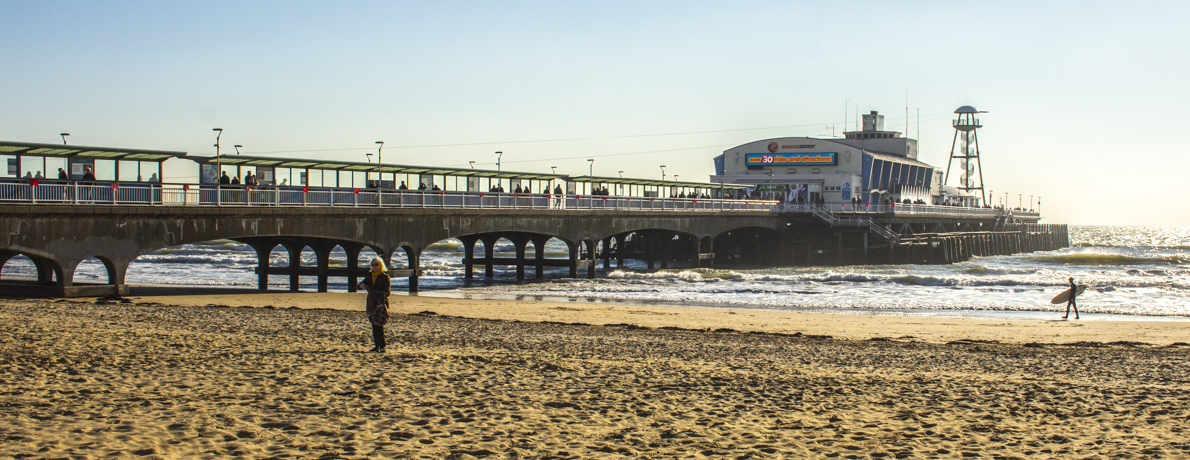
Bournemouth Pier
Royal Bath Hotel in Bournemouth
Overlooking the pier from its elevated position on Bath Road is the imposing Royal Bath Hotel. The Bath Hotel opened in 1838 on the day of Queen Victoria’s coronation. It was re-named the Royal Bath Hotel, in honour of the Prince of Wales who stayed there in 1856. Famous guests that came here to enjoy the splendid surroundings of this hotel included David Lloyd George, Benjamin Disraeli and Oscar Wilde. Wilde was such a regular that the hotel’s restaurant, Oscars, was named after him. As far as the history of Bournemouth is concerned its most interesting visitor was the wealthy Merton Russell-Cotes who subsequently bought the hotel in 1876. It was refurbished and re-opened in 1881.
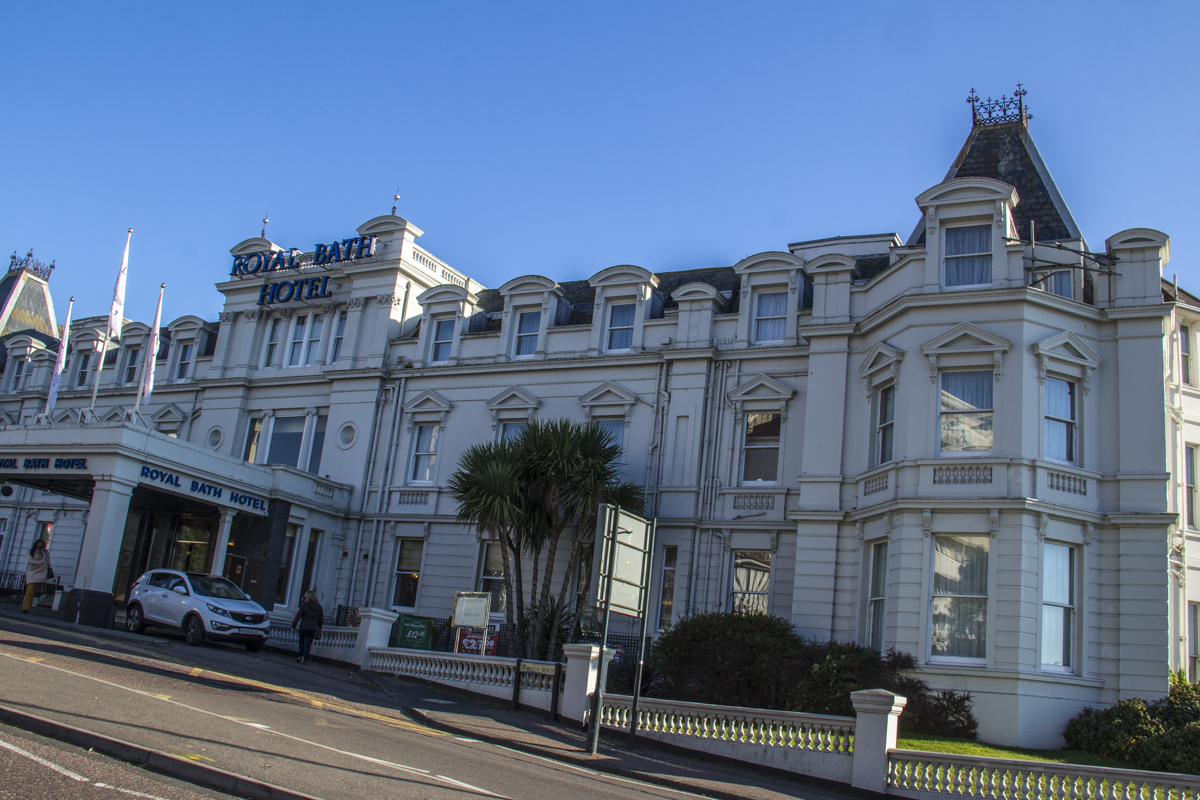
The Royal Bath Hotel in Bournemouth
The Russell-Cotes Museum in Bournemouth
While Merton Russell-Cotes his wife Annie lived in the Royal Bath Hotel they travelled extensively and built up a large collection of art and artefacts. At first the collection was displayed around the hotel but when it became too big Russell-Cotes decided to build a house next to the hotel. In 1901 Merton Russell-Cotes gave East Cliff Hall a villa on a cliff-top, overlooking the sea, to his wife Annie. As Queen Vitoria died in 1901 it was one of the last Victorian buildings ever to be built. The villa was never intended to be a family home and did not have a kitchen. Staff from the hotel cleaned the house. There was a bell under the table in the dining room which they would ring when they required food from the hotel. The gate the staff used to come and go can still be seen in the grotto in the “garden”: http://russellcotes.com/garden/.
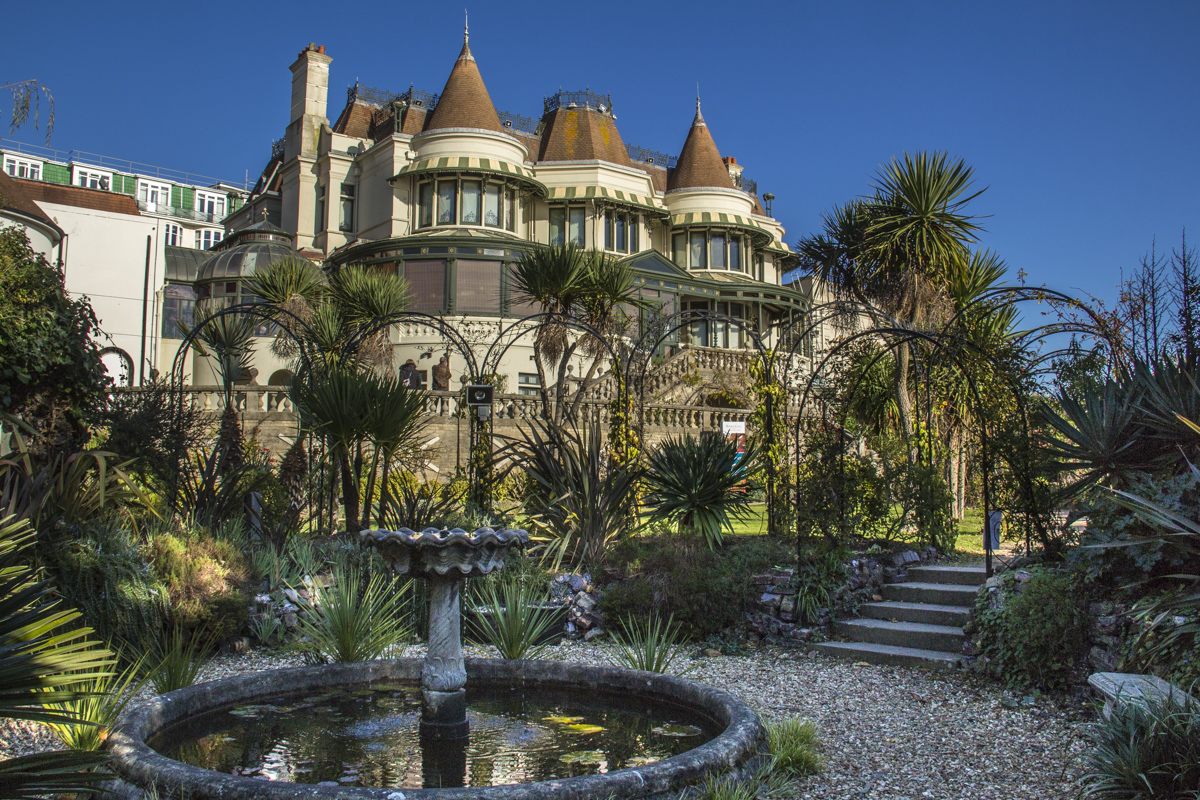
The Russell-Cotes Museum in Bournemouth
Every available space in the house was filled with paintings, sculptures and other objects acquired during their travels. A collection so large that today it is only possible to display ten percent at any one time. In 1908 the Russell-Cotes gave the villa and its contents to the people of Bournemouth. They continued to live there until they died – Annie in 1920 and Merton in 1921. In theory the house was open to the public but in practice this was a rare occurrence. In 1922 Bournemouth Borough Council opened the property to the public as an art gallery and museum. Today the house and galleries are a registered charity and are run with the support of volunteers who have the unenviable task of cleaning all the exhibits every Monday when the museum is closed. The rooms in the house look just the same as they did when the Russell-Cotes lived there – although not as cluttered. These rooms are a fascinating collection of showcases reflecting the lifestyle this couple enjoyed. My favourite room was Merton’s study, splashed with sunlight streaming through windows that face the sea.

The Study at the Russell-Cotes Museum in Bournemouth
The collections include the Japanese collection in the Mikado’s Room. This is one of the most important Japanese collections in the world. The Irving Room is devoted to the actor Henry Irving the first actor to be knighted in Britain. He was a good friend of Merton and Annie would stay at the Royal Bath Hotel whenever he visited Bournemouth to perform at local theatres. Merton persuaded his friend to part with many of the items that now form part of this unique collection. But the one that intrigues me most was the A to Z of the Russell-Cotes a very personal collection based on the alphabet.

The A to Z of the Russell-Cotes in the Russell-Cotes Museum
Accessed through the Main Hall are four galleries that showcase the artwork in the Russell-Cotes Museum. Between 1916 and 1919 Annie Russell-Cotes funded the building of the first three galleries. This meant the largest works of art in their collection could be put on display. The freehold of the site and the art galleries were also gifted to the people of Bournemouth by Annie. To fulfil the wishes of their parents two of the children added the fourth gallery which was also given to the town. This gallery is used for temporary exhibitions. There was so much more to see at the Russell-Cotes Museum than I had anticipated and I could have spent the rest of the day there. But, after a short break and a coffee with a tasty cheese scone in the café it was time to move on.
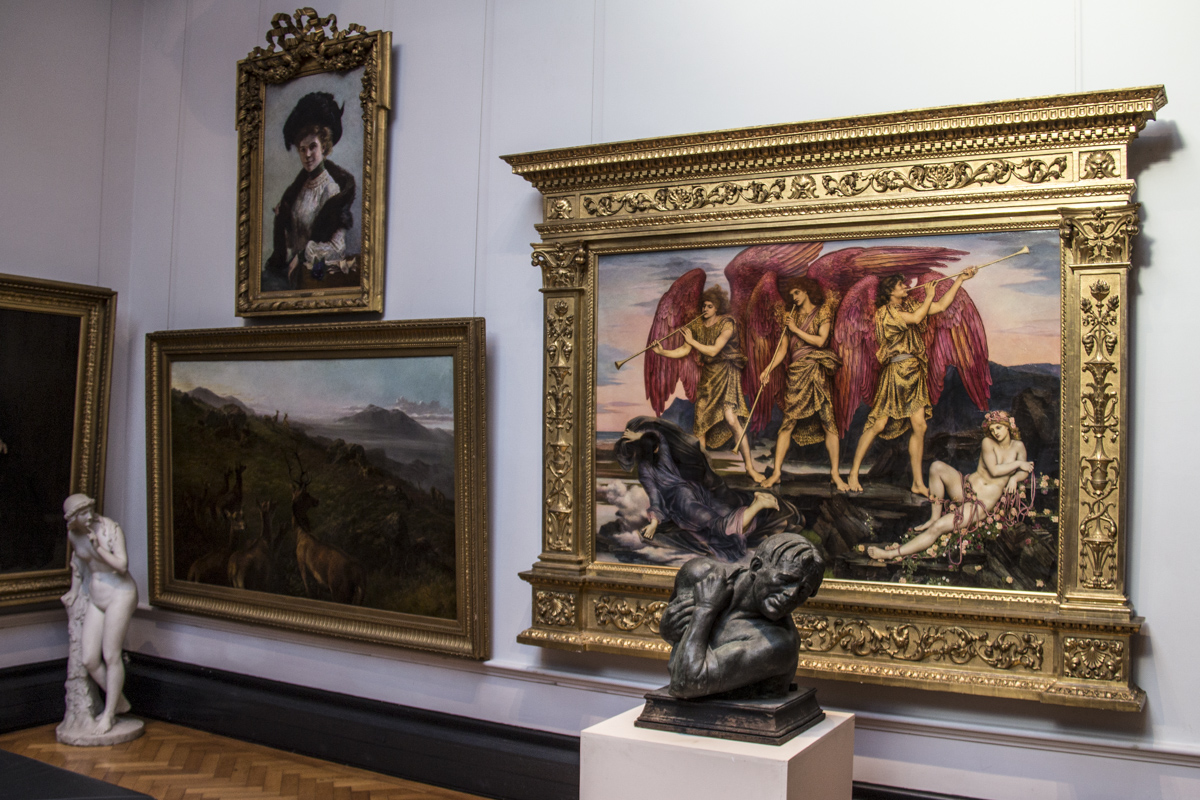
Art Gallery in the Russell-Cotes Museum
The Bournemouth Pavilion
Walking down the hill towards the seafront I passed the Pavilion a seaside theatre opened in 1929. At the time it was considered to be the largest municipal enterprise ever created to entertain the public. Since its triumphant opening the Pavilion has had mixed fortunes. These included the unpopular addition of an ugly extension in 1975 that ruined the Art Deco architecture of the building. Fortunately, the theatre has undergone a refurbishment programme which included the removal of this extension and the restoration of its Western Terrace. Today, this impressive listed building offers a full programme of entertainment.

The Bournemouth Pavilion
The Observation Wheel of Bournemouth
I never could resist a Big Wheel and I was soon swinging gently as I rose above the seafront in one of the carriages on the Observation Wheel. Below me I could see the Lower Gardens on one side and Bournemouth Pier on the other. What a lovely way to appreciate the pretty landscape surrounding me.
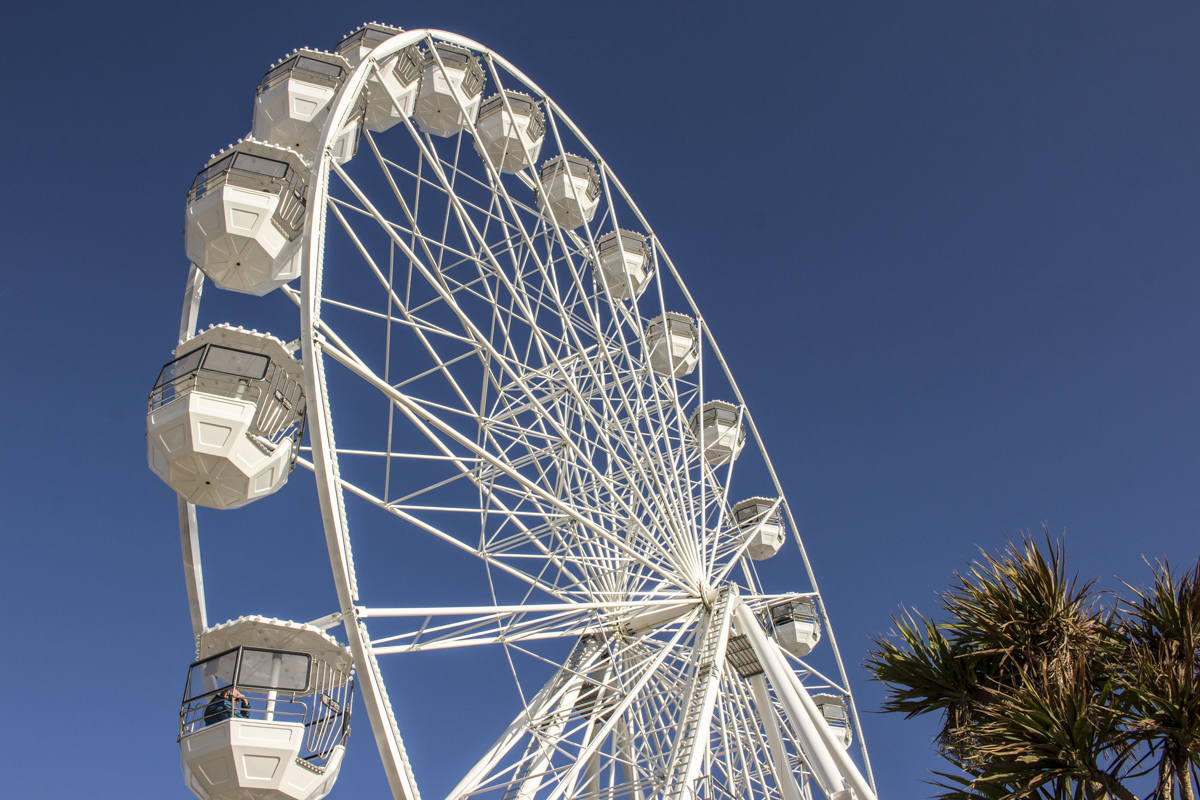
The Observation Wheel in Bournemouth
The Zip Wire in Bournemouth
Adrenalin pumping, I was ready for a top up on the zip wire. I made my way onto Bournemouth Pier http://www.thebournemouthpier.com (free entrance) and walked down to the Rock Reef http://rockreef.co.uk/pierzip/ building near the end from the top of a steel tower at the end of the pier. I did pause to watch the surfers below me. As the wind was quite strong there were some good waves coming in. Beyond the sandy beaches and blue sea of Bournemouth’s sea front I could see the white cliffs of the Jurassic Coast. https://jurassiccoast.org With helmet and harness in place I walked to the very end of the pier and climbed the steel tower. By the time I got to the top the wind had increased in strength and I had to wait for it to drop. Once the all-clear was given the gate in front of me was opened so I walked to the edge of the platform and stepped into thin air. Any apprehension I had felt was immediately replaced by elation as I whizzed down the wire. It really was thrilling.

The Zip Wire at Bournemouth
The Oceanarium on Bournemouth Pier
From my elevated position above the pier I had spotted the Oceanarium and decided to investigate. The central feature of the oceanarium is the main tank that has a tunnel running through it so visitors can watch sea creatures all around them. This well-designed building offers both family entertainment, educational visits and conservation programmes. It also features some cute side shows like the penguins and the otters. The penguin pond is also home to some Inca Terns who fly freely above the water. My visit coincided with feeding time for the otters so I stayed to watch these fascinating creatures racing around their enclosure seeking out the food that had been hidden by their keeper. The whole experience was most enjoyable but I had another attraction in my sights before the light faded – Boscombe Pier.

Otters at the Oceanarium in Bournemouth
Boscombe Pier in Bournemouth
I could have taken the Land Train which runs along the seafront between Bournemouth Pier and “Boscombe Pier”:“https://www.visitbournemouth.com/attractions/boscombe-pier but I decided to walk. It was very pleasant strolling along with the wind caressing my face and the sound of the waves crashing on the sand in my ears. It was not long before I began finding activities associated with this stretch of the shore known as the” Coastal Activity Park”:https://www.visitengland.com/experience/take-wild-break-coastal-activity-park. This park stretches for seven miles along the golden, sandy beaches. It includes a number of free outdoor activities and its popularity is enhanced by the warmer than average climate experienced here. I could have indulged in some exercising encouraged by some static robots but declined the offer.

The Coastal Activity Park in Bournemouth
The history of Boscombe Pier is told on a series of information boards at the end of the pier. The pier was originally built in 1888 and the last renovation was in 2008. It has survived two World Wars and it is still popular today for promenading and enjoying the views on either side of the viewing platform at the end of it. The pier also has a musical trail. Some large hand-crafted musical instruments including Tubular Bells, bespoke Seaside Chimes and a Bell Lyre have been installed on the pier and visitors are encouraged to have a go at playing them. If your preference is for mini-golf then try the fish-friendly version that stretches along the pier. If your golf ball drops into the sea the fish will soon gobble it up as they are made of fish food. And you can always buy another one.
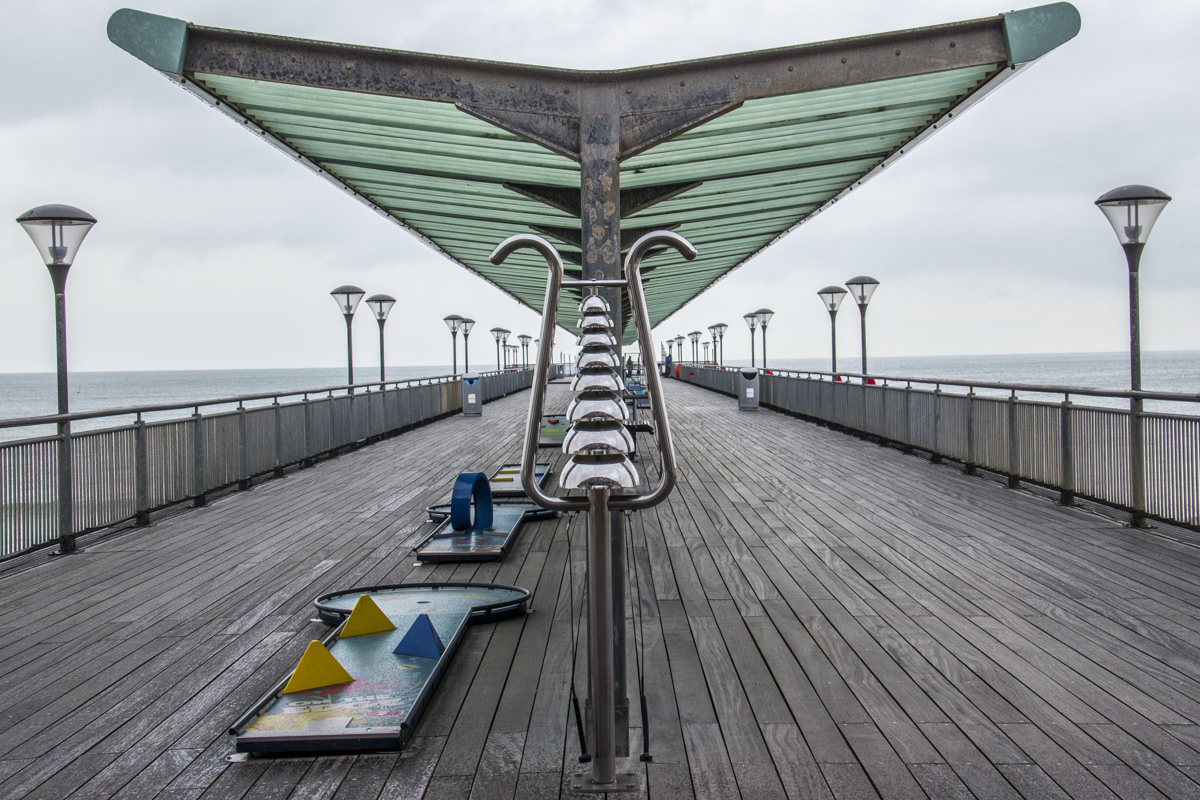
Boscombe Pier in Bournemouth
On this visit I had seen another aspect of Bournemouth – its seafront. A complete contrast to the gardens I had admired on my last visit.
Where to Stay in Bournemouth
Immediately upon entering the Collingwood Hotel in Bournemouth I felt the warmth of a friendly welcome. My room was lovely, spacious, light and well-equipped. Newly refurbished, my feet sank into the plush carpet. I was soon enjoying a refreshing cup of tea in my recessed window accompanied by some delicious short bread.

Bedroom in the Collingwood Hotel in Bournemouth
I dined in the hotel that night. Three courses of tasty wholesome food. My dessert, white chocolate and raspberry cheesecake, was scrumptious. It had been recommended by my waiter, Viktor, a Hungarian from Budapest. I enjoyed reminiscing about one of my favourite cities and impressed that Viktor did not allow our conversation to interfere with his duties. The other guests in the hotel were also very friendly and I felt comfortable striking up a conversation with them. I discovered that many of them were regular visitors – some of them have been coming here for twenty years. I was beginning to understand why.

Collingwood Hotel in Bournemouth
Collingwood Hotel is ideally placed for both the sea front and the town centre. Should it be too cold or wet to venture outside there is a small gymnasium and a swimming pool for indoor exercising.

Leisure Area at the Collingwood Hotel in Bournemouth
Where to Eat in Bournemouth
Neo, a cocktail bar and restaurant overlooking the sea front, is more than just a place to have a drink or a meal – it is an experience. It’s rotunda shape offers great views of Bournemouth and its sea front. Knowledgeable waiters will talk you through an extensive selection of cocktails. I opted for a gin and tonic and then had to choose which gin from a long list. Lilliput, a local gin, was my final choice. Enhanced with a sprig of rosemary and a sprinkling of juniper berries it was super.

Neo cocktail bar and restaurant in Bournemouth
I dined in the restaurant upstairs and started my meal with some fresh crab. This was followed by slow cooked pork belly. Personally, I think it would have benefited from less pork and more garnish but it was nevertheless very good. I finished with a no frills blackberry and almond pudding accompanied by a creamy vanilla ice cream. Simple but superb. A great experience.
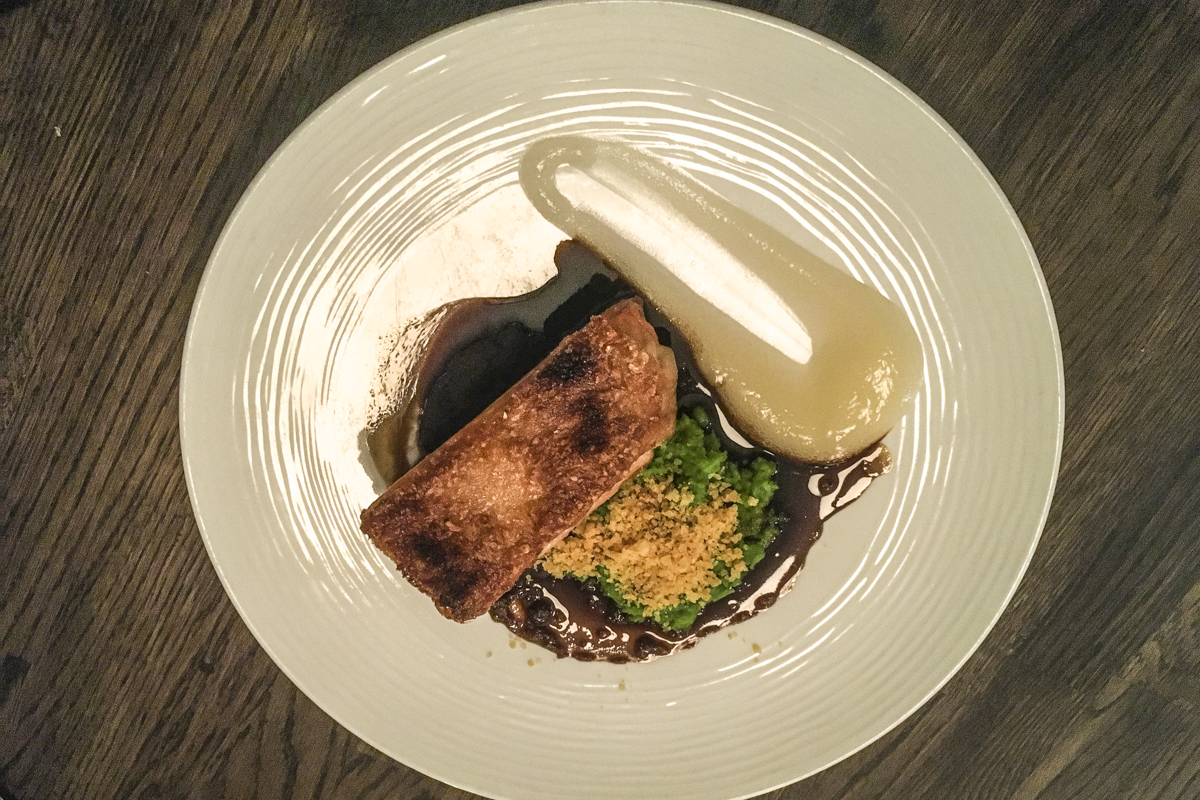
Pork belly main course at Neo in Bournemouth
Getting there
Bournemouth is easily accessible by road via the M3 and M27 but the roads do get very busy during the summer. There are regular trains from London Waterloo and very local bus services with day tickets available.
Available on GPSmyCity.com
This article is now featured on GPSmyCity. To download this article for offline reading or travel directions to the attractions highlighted in this article, go to Walking Tours in Bournemouth on GPSmyCity
This article was based on the personal experience of Valery, an ExperiencedTraveller.